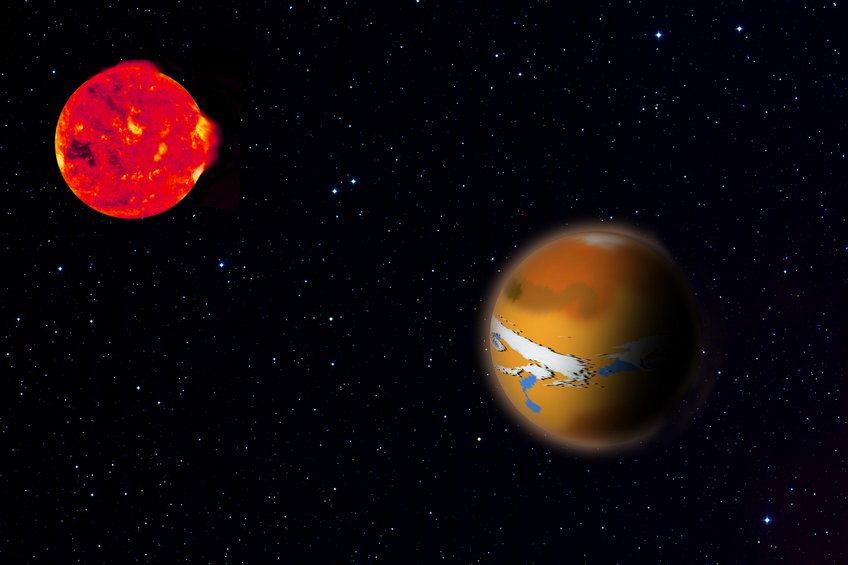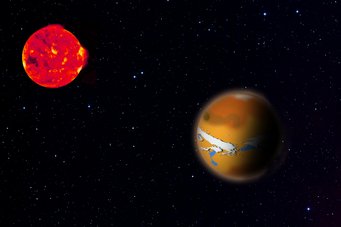Traces of life on nearest exoplanets may be hidden in equatorial trap, study finds
| Background information | Download area | In-depth description of the results |
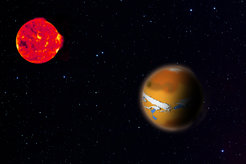
How can we hope to detect life on an exoplanet – planet orbiting a star other than the Sun? The accepted search strategy is as follows: Examine an exoplanet's atmosphere and identify chemical compounds that were produced by living beings, like the massive amount of oxygen in Earth's atmosphere. But now researchers led by Ludmila Carone of the Max Planck Institute for Astronomy have found that these traces might be hidden better than was previously thought.
Carone and her team considered some of the nearest exoplanets that have the potential to be Earth-like:
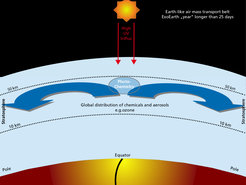
Proxima b, which is orbiting the star nearest to the Sun (Proxima Centauri), and the most promising of the TRAPPIST-1 family of planets: TRAPPIST-1d. These planets are so close to their host stars that they should be in "bound rotation": The gravitational interaction between planets and host star rotates the planet into a "preferred orientation." The result is that one side of the planet that always faces the host star ("eternal day-side") and another side that always faces away from the star ("eternal night").
Modeling the flow of air within the atmospheres of these planets, Carone and her colleagues found that the unusual day-night-divide can have a marked effect on the search for life on such a planet. The reason is that one of the compounds used as a tracer in most search strategies, namely ozone, is affected by these unusual conditions. In Earth's atmosphere, this compound forms the ozone layer that protects us from the Sun's harmful UV radiation. On an alien planet, ozone, as a variety of oxygen, could be one piece in the puzzle that indicates the presence of oxygen-producing bacteria or plants.
So does that mean that whenever we observe no ozone, the planet is lifeless? Not necessarily, according to Carone and her team. The reason involves large-scale air-flows. On Earth, these flows go from the equator towards the poles, evenly distributing the ozone across the atmosphere. But for planets in bound rotation, things can be different. At least for those planets that orbit their host star in 25 days or less, the major air flow will lead from the poles to the equator, systematically trapping the ozone in the equatorial region.
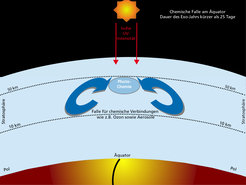
Ludmila Carone says: "Absence of traces of ozone in future observations does not have to mean there is no oxygen at all. It might be found in different places than on Earth, or it might be very well hidden." This needs to be taken account when strategies for the search for life on other planets are formulated. "On the other hand," says Carone, "we all knew from the beginning that the hunt for alien life will be a challenge. As it turns out, we are only just scratching the surface of how difficult it really will be."
Would an Earth-like exoplanet with an ozone layer that covers only the equatorial regions, or is altogether absent, even be habitable, unprotected as it is from UV radiation? "In principle: yes," Carone says. "Proxima b and TRAPPIST-1d orbit red dwarfs, reddish stars that emit very little harmful UV-light to begin with. On the other hand, these stars can be very temperamental, and prone to violent outbursts of harmful radiation including UV. There is still a lot that we don't know about these red dwarf stars. But I'm confident we will know much more in five years." The combination of advances in modeling and much better data from telescopes like the James Webb Space Telescope is likely to lead to significant progress in this exciting field.
Background information
The results described here have been published in Carone et al., " Stratosphere circulation on tidally locked ExoEarths" in the Monthly Notes of the Royal Astronomical Society.
The MPIA researchers involved are Ludmila Carone and Thomas Henning, in collaboration with Rony Keppens and Leen Decin (both Katholieke Universiteit Leuven).
Additional figures and download

Figure 1

Figure 2

